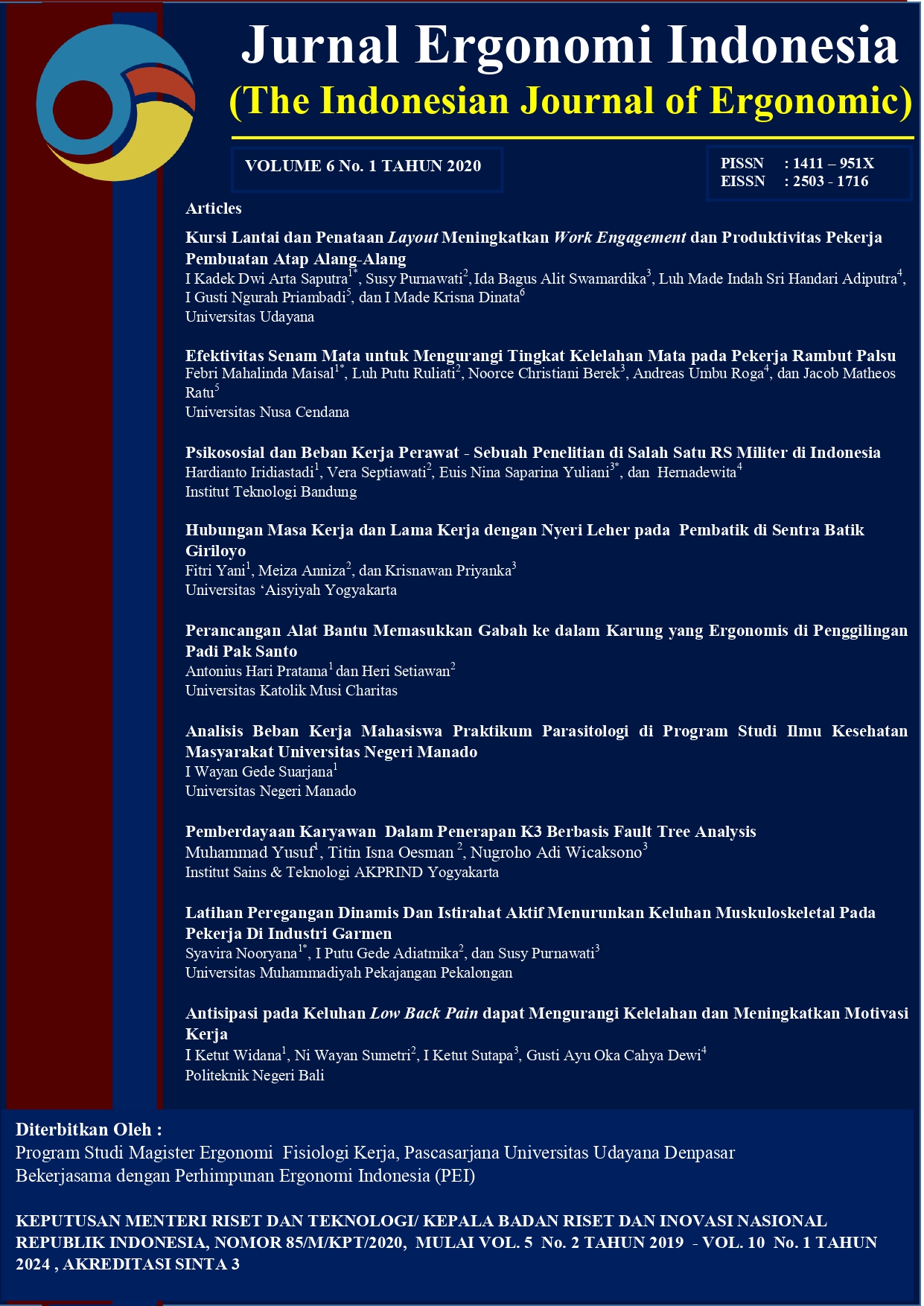Kursi Lantai dan Penataan Layout Meningkatkan Work Engagement dan Produktivitas Pekerja Pembuatan Atap Alang-Alang
PROVINDING OF FLOOR CHAIR AND LAYOUT ARRANGEMENT IMPROVE WORK ENGAGEMENT AND PRODUCTIVITY OF WORKERS MAKING REEDS ROOF
Abstract
Workers making reeds roofs work with a working posture sitting on the floor with a slightly bent back. Intervention by giving floor chairs as a base during work as well as structuring the production process layout. This study aims to improve work engagement and productivity of workers making reeds roofs in Gianyar. The research design used was experimental with randomized pre-posttest control group design involving 16 randomly selected research samples. The subjects in this study were divided into two groups: the control group were workers who worked as usual and the treatment group were workers who worked using floor chairs and structuring the production process layout. Work engagement was recorded using the UWES 17 questionnaire and productivity was recorded from the number of Imperata roofs produced. Data analysis used parametric tests with a value of ? 0.05 for normally distributed data and non-parametric tests for data that were not normally distributed. The results showed a significant difference in work engagement and productivity (p<0.05). In the control group the mean score of work engagement was 50.75 and the productivity was 0.067. Whereas in the treatment group the average score of work engagement was 71.12 and productivity was 0.015. Giving floor chairs and structuring the layout of the production process is proven to increase work engagement by 40.13% and increase productivity by 34.60%. It can be concluded that the application of ergonomics in the form of providing floor chairs and structuring the layout of the production process is proven to increase work engagement and work productivity in workers making reeds roofs.
Downloads
References
Daryono. 2016. “Redesain Rakel dan Pemberian Peregangan Aktif Menurunkan Beban Kerja dan Keluhan Muskuloskeletal Serta Meningkatkan Produktivitas Kerja Pekerja Sablon Pada Industri Sablon Surya Bali di Denpasar” (tesis). Denpasar: Program Pasca Sarjana Universitas Udayana.
Demerouti, E., dan Bakker, A.B. 2007. The oldenberg burnout inventory: A good alternative to measure burnout (and engagement). Measurement of Burnout and Engagemen.
Depkes RI. 2015. Profil Kesehatan 2015. Departemen Kesehatan RI
Dinata, IM.K., Adiputra, N., dan Adiatmika, IP.G. 2015. Sikap Kerja Duduk-Berdiri Bergantian Menurunkan Kelelahan, Keluhan Muskuloskeletal Serta Meningkatkan Produktivitas Kerja Penyeterika Wanita di Rumah Tangga. Jurnal Ergonomi Indonesia, Vol. 1(1):32-37.
Federmen, B. 2009. Employee Engagement: A Road For Creating Profits, Optimizing Perfomance, And Increasing Loyalty. San Fransisco: Jossey Bass.
Hamzah. A. 2018. “Pemberian Alas Duduk dan Mc Kenzie Exercise Menurunkan Ketegangan Otot dan Keluhan Muskuloskeletal Serta Meningkatkan Produktivitas Kerja Pengukir Gendang Tambur di UD Budi Luhur Gianyar” (tesis). Denpasar: Program Pascasarjana Universitas Udayana.
Khan, N. 2013. Employee Engagement Drives for Organizational Succes.
Leskova, A. 2014. Designing of Manual Worksation Structure With Emphasis on Ergonomics. ACTA TECHNIKA Bulletin of Engineering.
Manuaba, A. 2004. Hubungan Beban Kerja Dan Kapasitas Kerja. Jakarta: Rineka Cipta.
Peraturan Menteri Kesehatan Republik Indonesia Nomor 70 Tahun 2016 tentang Standar dan Persyaratan Kesehatan Lingkungan Kerja Industri. Jakarta: MENKES
Shivela, S. 2016. Intervensi untuk Meningkatkan Work Engagement pada PT. XYZ Berdasarkan Faktor Occupational Self-efficacy, Psychological Hardiness dan Perceived Organizational Support. (tesis) Depok: Universitas Indonesia.
Suarjana, IG.W. 2018. “Redesain Alat Pemarut Kelapa Mengurangi Beban Fisiologis dan Meningkatkan Produktivitas Kerja Pada Pekerja Industri Adonan Luluh Sate di Kediri Tabanan” (tesis). Denpasar: Program Pascasarjana Universitas Udayana.
Suma’mur, 2011. Keselamatan Kerja Dan Pencegahan Kecelakaan. Jakarta : CV Haji Masagung
Tolman, dan Wiker. 2012. Why employee engagement has a direct impact on your business bottom line.
Wingjosoebroto, S. 2003. Ergonomi, Studi Gerak dan Waktu. Teknik Analisis untuk Peningkatan Produktifitas Kerja (Cetakan Ke 2). Surabaya: Guna Widya.
Yusuf, M. 2016. “Desain Alat Pelubang Plastik Mulsa dan Sistem Kerja dengan Intervensi Ergonomi Meningkatkan Produktivitas Kerja Petani di Bedugul Bali” (disertasi). Denpasar: Program Pascasarjana Universitas Udayana.

















